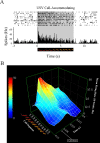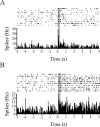Single-unit firing in rat perirhinal cortex caused by fear conditioning to arbitrary and ecological stimuli
- PMID: 17989293
- PMCID: PMC6673244
- DOI: 10.1523/JNEUROSCI.1653-07.2007
Single-unit firing in rat perirhinal cortex caused by fear conditioning to arbitrary and ecological stimuli
Abstract
Pretraining lesions of rat perirhinal cortex (PR) severely impair pavlovian fear conditioning to a 22 kHz ultrasonic vocalization (USV) cue. However, PR lesions are without significant effect when the cue is a continuous tone at the same or a lower frequency. Here we examined fear-conditioning-produced changes in single-unit firing elicited in rat PR by a 22 kHz tone cue or a 22 kHz USV cue. Chronic recording electrodes were introduced from the lateral surface of the skull. Altogether, 200 well isolated units were studied in 28 rats. Overall, 73% of the recorded single units (145 of 200 units) evidenced statistically significant firing changes in response to the tone or USV conditional stimulus (CS) after it had been paired several times with an aversive unconditional stimulus (US). Interestingly, 33% of units (66 of 200 units) that were initially CS-unresponsive became CS-responsive after conditioning. After conditioning, there were two notable differences between single-unit responses elicited by the USV cue and those elicited by the tone cue. First, 11% of the units (14 of 123 units) recorded from the USV-conditioned group displayed a precisely timed increase in firing rate during the 260 ms interval in which the US had previously occurred. This US-timed response was unique to the USV-conditioned group. Second, the mean latency of cue-elicited firing was approximately 30 ms longer in the USV-conditioned group than in the tone-conditioned group. These cue-specific differences in acquired firing latencies and acquired firing patterns suggest that spectrotemporal properties of a CS can control the essential circuitry or neurophysiological mechanisms underlying fear conditioning.
Figures











Similar articles
-
Perirhinal cortex supports delay fear conditioning to rat ultrasonic social signals.J Neurosci. 2004 Apr 7;24(14):3610-7. doi: 10.1523/JNEUROSCI.4839-03.2004. J Neurosci. 2004. PMID: 15071109 Free PMC article.
-
Single-unit responses to 22 kHz ultrasonic vocalizations in rat perirhinal cortex.Behav Brain Res. 2007 Sep 4;182(2):327-36. doi: 10.1016/j.bbr.2007.03.009. Epub 2007 Mar 16. Behav Brain Res. 2007. PMID: 17445914 Free PMC article.
-
Fear conditioning to discontinuous auditory cues requires perirhinal cortical function.Behav Neurosci. 2008 Oct;122(5):1178-85. doi: 10.1037/a0012902. Behav Neurosci. 2008. PMID: 18823174
-
Dual functions of perirhinal cortex in fear conditioning.Hippocampus. 2012 Oct;22(10):2068-79. doi: 10.1002/hipo.22058. Epub 2012 Aug 18. Hippocampus. 2012. PMID: 22903623 Free PMC article. Review.
-
Asymmetrical stimulus generalization following differential fear conditioning.Neurobiol Learn Mem. 2008 Jul;90(1):200-16. doi: 10.1016/j.nlm.2008.02.009. Epub 2008 Apr 22. Neurobiol Learn Mem. 2008. PMID: 18434217 Free PMC article.
Cited by
-
Postrhinal cortex contributions to the expression of auditory fear conditioning.Neurobiol Learn Mem. 2022 May;191:107609. doi: 10.1016/j.nlm.2022.107609. Epub 2022 Mar 8. Neurobiol Learn Mem. 2022. PMID: 35276336 Free PMC article.
-
Differential responsivity of neurons in perirhinal cortex, lateral entorhinal cortex, and dentate gyrus during time-bridging learning.Hippocampus. 2019 Jun;29(6):511-526. doi: 10.1002/hipo.23041. Epub 2018 Nov 25. Hippocampus. 2019. PMID: 30311282 Free PMC article.
-
Controlling the elements: an optogenetic approach to understanding the neural circuits of fear.Biol Psychiatry. 2012 Jun 15;71(12):1053-60. doi: 10.1016/j.biopsych.2011.10.023. Epub 2011 Dec 14. Biol Psychiatry. 2012. PMID: 22169096 Free PMC article. Review.
-
β-Adrenoceptors and synaptic plasticity in the perirhinal cortex.Neuroscience. 2014 Jul 25;273(100):163-73. doi: 10.1016/j.neuroscience.2014.04.070. Epub 2014 May 14. Neuroscience. 2014. PMID: 24836853 Free PMC article.
-
Characterization of auditory synaptic inputs to gerbil perirhinal cortex.Front Neural Circuits. 2015 Aug 14;9:40. doi: 10.3389/fncir.2015.00040. eCollection 2015. Front Neural Circuits. 2015. PMID: 26321918 Free PMC article.
References
-
- Anderson JW. The production of ultrasonic sounds by laboratory rats and other mammals. Science. 1954;119:808–809. - PubMed
-
- Bang S, Allen TA, Jones LK, Boguszewski P, Brown TH. Asymmetrical generalization gradients toward social alarm calls in rats given differential fear conditioning. Soc Neurosci Abstr. 2006;32:67–15.
Publication types
MeSH terms
Grants and funding
LinkOut - more resources
Full Text Sources
Research Materials
